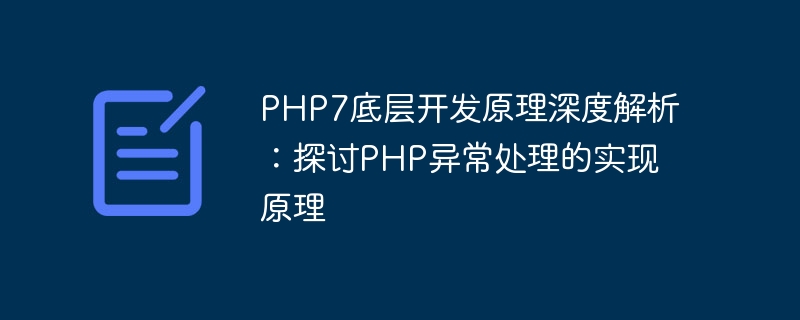

In-depth analysis of the underlying development principles of PHP7: Discussing the implementation principles of PHP exception handling
Introduction:
Exception handling is one of the very important features in modern programming languages , which provides an elegant and efficient way to handle errors and exceptions that may occur during program execution. In PHP7, the exception handling mechanism has been greatly improved and optimized. This article will deeply explore the implementation principles of PHP exception handling.
1. Introduction to exception handling mechanism
Exception handling is a mechanism that captures and handles errors and exceptions during program execution. In PHP, the exception handling mechanism consists of try-catch-finally statement blocks. The code segment contains code that may throw exceptions. When an exception occurs, the program will jump to the corresponding catch block for exception handling.
try {
// 可能抛出异常的代码
} catch (Exception $e) {
// 异常处理代码
} finally {
// 最终执行代码
}
In the above code block, the code in the try block is the code segment that may throw an exception. When an exception is thrown, the code in the catch block will be checked in turn to find the catch block that matches the exception type for processing. If no matching catch block is found, the exception will be passed up the call stack.
2. Implementation Principle of Exception Handling
The implementation principle of PHP exception handling involves some key mechanisms underlying PHP.
class MyException extends Exception {
// 自定义异常类
}
function divide($numerator, $denominator) {
if ($denominator == 0) {
throw new Exception('除数不能为零');
}
return $numerator / $denominator;}
try {
echo divide(10, 0);
} catch (Exception $e) {
echo '捕获到异常:' . $e->getMessage();
}
In the above code, when "divisor" is thrown Cannot be zero" exception, "Caught exception: divisor cannot be zero" will be displayed in the catch block.
function foo() {
try {
bar();
} catch (Exception $e) {
echo '捕获到异常:' . $e->getMessage();
}}
function bar() {
throw new Exception('抛出异常');}
In the above code , the thrown exception is passed from the bar function to the foo function, and is finally caught in the catch block of the foo function.
try {
echo divide(10, 2);
} catch (Exception $e) {
echo '捕获到异常:' . $e->getMessage();
} finally {
echo '最终执行';
}
In the above code, regardless of whether the divide function throws an exception, "final execution" will be output.
Conclusion:
Through the introduction of this article, we understand the implementation principle of PHP exception handling. The exception handling mechanism can effectively help us capture and handle errors and exceptions during program execution, making the program more stable and robust. During the development process, we can customize exception classes according to actual needs to better describe and handle different types of errors and exceptions.
Reference:
The above is the detailed content of In-depth analysis of the underlying development principles of PHP7: Discussing the implementation principles of PHP exception handling. For more information, please follow other related articles on the PHP Chinese website!




